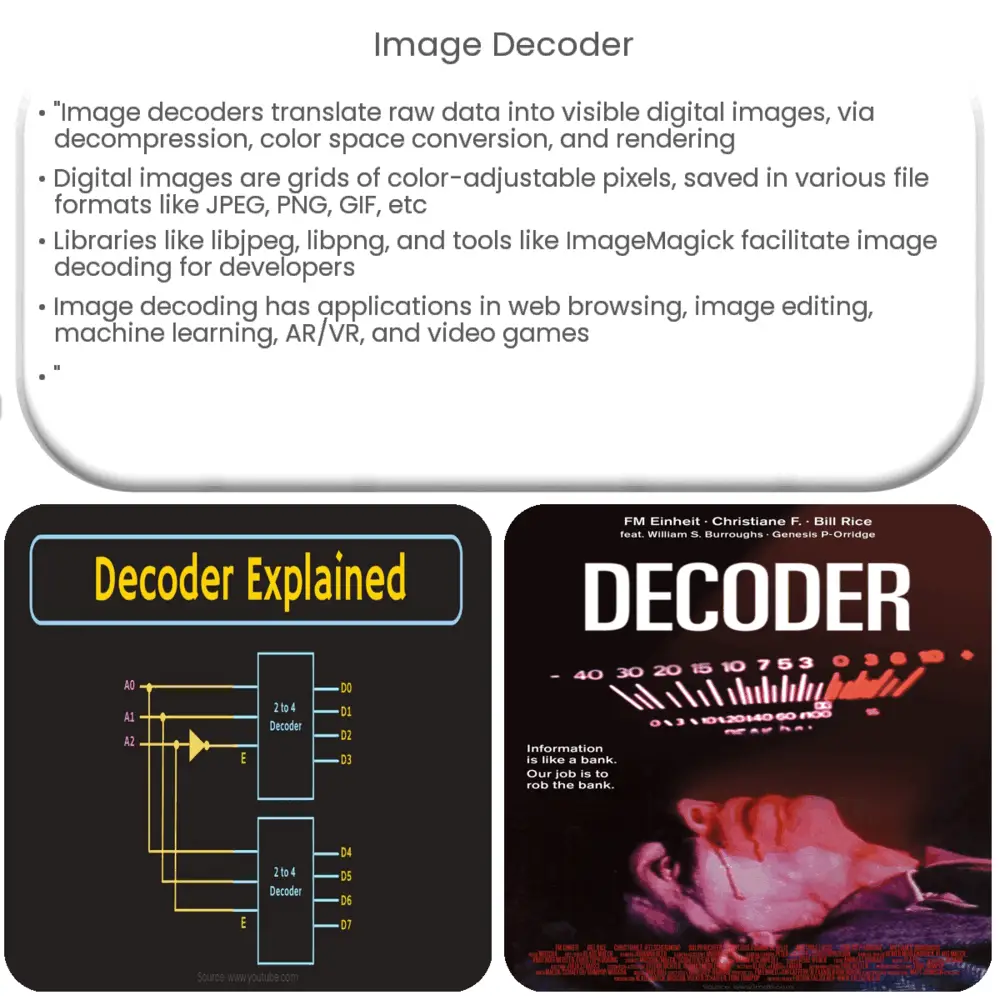Image decoders convert raw binary data in image files into visual representations, enabling seamless display and manipulation of digital images.

Image Decoder: Unraveling the Mystery of Digital Images
Images are an essential part of our daily lives, allowing us to capture memories, communicate ideas, and share experiences. They are a universal language that transcends linguistic and cultural barriers, and with the ever-growing prevalence of digital technology, images have become more accessible and easier to create. But, how do computers actually understand and decode these images? In this article, we will explore the fascinating world of image decoders, the technology responsible for translating raw data into the beautiful pictures we see on our screens.
The Basics of Digital Images
Before diving into image decoders, it’s important to understand the basic structure of a digital image. A digital image is a grid of tiny dots called pixels, each with a specific color value. The number of pixels in an image is referred to as its resolution, with higher resolution images containing more pixels and thus, more detail. The color of each pixel is determined by a combination of three primary colors: red, green, and blue (RGB). The intensity of these colors can be adjusted to create millions of different color combinations, allowing for a wide range of hues and shades.
Image File Formats
When an image is captured, whether by a digital camera or a scanner, it needs to be saved in a specific file format. There are numerous image file formats available, each with its own unique characteristics and uses. Some of the most popular file formats include JPEG (Joint Photographic Experts Group), PNG (Portable Network Graphics), GIF (Graphics Interchange Format), and BMP (Bitmap). These formats vary in their compression techniques, image quality, and support for transparency or animation, among other features.
Understanding Image Decoders
An image decoder is a piece of software or hardware that interprets the binary data stored in an image file and converts it into a visual representation that can be displayed on a screen. This process is known as decoding, and it involves various steps, including decompression, color space conversion, and rendering.
Decoding begins with the decompression stage, where the raw binary data stored in the image file is unpacked to reveal the original pixel information. This is particularly important for formats like JPEG, which use lossy compression techniques to reduce file size at the expense of some image quality. Once the data is decompressed, it undergoes color space conversion, where the color values are adjusted to match the specific color space used by the target display device. Finally, the decoded pixel data is rendered on the screen, creating the visual representation of the image that we see and recognize.
Common Image Decoder Libraries and Tools
There are several widely-used image decoder libraries and tools available for various programming languages and platforms. These libraries make it easy for developers to work with and manipulate digital images in their applications. Some of the most popular image decoder libraries include:
- libjpeg: A widely-used open-source library for handling JPEG images, supporting encoding, decoding, and various image manipulation functions.
- libpng: A robust, open-source library for working with PNG images, offering support for decoding, encoding, and various image processing features.
- libgif: An open-source library for managing GIF images, including support for decoding, encoding, and animation.
- ImageMagick: A powerful, open-source software suite for creating, editing, and converting various image formats, including JPEG, PNG, GIF, and many others.
- OpenCV: An open-source computer vision library with extensive support for image processing, including decoding and encoding of multiple image formats, as well as numerous image manipulation and analysis functions.
Applications of Image Decoding in the Real World
Image decoding plays a crucial role in many everyday applications, from basic image viewing and editing software to more specialized fields such as:
- Web Browsers: When loading a webpage with images, browsers use image decoders to display the images correctly on the screen.
- Image Editing Software: Programs like Adobe Photoshop and GIMP rely on image decoders to open and manipulate various image formats.
- Computer Vision and Machine Learning: Image decoders are an essential part of pre-processing pipelines for computer vision and machine learning applications, allowing algorithms to analyze and learn from visual data.
- Augmented and Virtual Reality: Image decoding is a key component in rendering realistic graphics for augmented and virtual reality experiences, ensuring accurate and seamless integration with the real world.
- Video Games: Game developers use image decoders to load and display textures, character models, and other graphical assets in video games.
Conclusion
Image decoders are a fundamental building block of digital image processing, enabling the seamless transition from raw binary data to the vivid and intricate visual experiences we enjoy every day. With a wide range of file formats, libraries, and tools available, image decoding continues to play a critical role in shaping the future of digital technology and communication.

